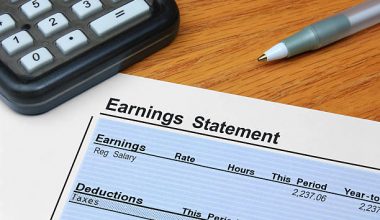Any amount you owe a taxation authority, such as the Internal Revenue Service, is your tax burden. Liability implies that you are legally liable for anything. Your overall tax debt may include unpaid taxes from previous years, among other things. It can be difficult to determine whether you have a tax responsibility and, if so, how much you owe, but understanding how your tax liability works will help you file and pay your taxes. That’s exactly why this article was crafted to help you understand all you need to know about, the federal income tax liability vs tax due calculator and how to exempt yourself. All that and much more are captured in this post. Read on!
What Is Tax Liability?
The amount of money you owe to tax authorities, such as your local, state, and federal governments, is known as your tax liability (e.g., the IRS). When you have a tax liability, you owe your creditor a legally binding debt. Individuals and businesses can both be subject to taxation.
Taxes are used by the government to fund social initiatives and administrative functions. The social security tax, for example, pays for retirement and disability payments.
Tax liabilities are obligations that are due right now. Current obligations are debts that must be repaid within a year. In most cases, typical business operations result in short-term liabilities. On your small business balance statement, include tax liabilities with other current debts.
Back taxes, a tax lien, penalties, interest, and even jail time can all occur from failing to pay a tax debt. If you are unable to pay your taxes owing to financial constraints, you may be able to work out a payment plan.
Overview
Taxes are levied by a number of agencies, including the federal, state, and municipal governments, who utilize the funds to fund services such as road repairs and national defense.
When a taxable event occurs, the taxpayer must know the event’s tax basis as well as the rate of tax on that base.
Taxes are owed in the form of sales tax and corporation payrolls. Many states and some municipal governments levy a sales tax on businesses when they sell their goods. Which is a percentage of the sale that is by the purchaser. Businesses report sales taxes to tax authorities on a monthly or quarterly basis. Companies deduct income taxes, as well as social security and medicare taxes, from employees’ paychecks and immediately transfer them to the federal government.
The tax liability of an individual or corporation is not to the current year. It takes into account any and all tax years for which money is owed. That means that any taxes (taxes from past years) are to the tax liability as well.
How Does Tax Liability Work?
According to the information you provided on your Form W-4, your employer most certainly deducted a portion of your pay for taxes during the year. On your behalf, they sent this money—your withholding—to the IRS. Line 25a of your 2021 tax return shows the amount.
If you’re self-employed, you may have made estimated tax payments during the year, or you may have received some unexpected income from which taxes were not withheld. Form 1040-ES, Estimated Tax for Individuals. This is to make these payments. Line 26 of your 1040 tax form should be filled up with the amount you paid. To calculate your tax burden, remove all of these payments from the amount shown on line 24.
If your tax due was $5,000 but the net of your payments plus refundable tax credits you qualified for was $7,500, you would receive a $2,500 refund. After calculating your refundable credits, you’d still owe the IRS $1,000 if your liability was $5,000 and you only made $4,000 in total payments.
How to Reduce Your Tax Liability
What can you do if you aren’t among those who have no income tax liability and wish to lower your tax bill? There are a couple of options.
This is where tax preparation software (such as TurboTax or H&R Block) or the services of an accountant can be extremely beneficial, but it is also feasible to handle it on your own.
You can also alter your payroll tax exemptions by filing a new W-4 with your employer if you want to minimize your tax payment. However, there are various schools of thought on this tax method. If you withhold too little, you’ll owe more in taxes. Nobody wants to be in such a situation.
On the one hand, you will have more money in your paycheck throughout the year, which you can invest to make money for yourself. On the other hand, increasing the amount withheld from your payroll taxes would lower your tax liability, but the government, not you, will be earning interest on that money throughout the year.
Donating to charity is another common way to reduce your tax liability. Tax deductions are available for donations to qualifying charities. A tax deduction lowers your taxable income, which lowers your tax obligation. Giving money or other assets away is a terrific method to reduce your tax bill while also supporting organizations that are important to you.
For all of your donations, it’s critical to acquire correct documentation. Of course, if you choose to itemize your deductions rather than take the standard deduction, you can only deduct donations.
Tax Liability vs Tax Due
Form W-4 is required to be filled out when you start new employment. Based on your filing status, family situation, and any additional employment you have, this notifies your employer how much to withdraw from your paychecks for income taxes.
Each payday, your employer submits the amount withheld for income taxes to the IRS on your behalf. Each company will send you a W-2 — or 1099 if you’re an independent contractor — at the start of each calendar year. Document how much you made and how much was withheld for taxes. Rather than withholdings, self-employed taxpayers usually pay their taxes quarterly.
If your financial status changes during the year, you must update and resubmit your W-4 to your employer to ensure that the proper amount of money is to pay your tax liability. Tax planning allows self-employed individuals to determine their tax liability.
You can apply tax credits to your tax bill to reduce the amount due on a dollar-for-dollar basis if you qualify. Some credits are even refundable, which means that the entire value of the credits exceeds your tax bill. You can get the money back in the form of a tax refund.
How Do You Estimate Tax Liability?
If you were to count up every dollar you earned in 2022 and then apply that sum to the tax tables that are located above, you would most likely arrive at a figure that is greater than the amount that you are really obligated to pay in taxes.
The tax system in the United States is progressive. That indicates that the government will tax different parts of your income at different rates, and those rates will increase as the sum of your income does so. In addition, the amount of your taxable income that is subject to taxation might be reduced by taking advantage of various deductions. In addition, the amount of the return may be directly impacted by specific credits.
How Much Federal Tax Should Be Withheld from My Paycheck?
Withhold from the employee’s paycheck an amount equal to one-half of the entire 15.3% (which is 7.65%, or 6.2% for Social Security and 1.45% for Medicare). You, as the employer, are responsible for paying the other half of the FICA taxes. The calculation for an employee with a hypothetical weekly wage of $1,500 is as follows: $1,500 multiplied by 7.65% (.0765), which results in a total of $114.75.
What Happens If I Didn’t Pay Federal Taxes?
If you filed your taxes on time but failed to pay some or all of the taxes that you owe by the deadline, you may be subject to a failure-to-pay penalty as well as interest on the amount that remains outstanding. The amount of the penalty for nonpayment is equivalent to one-half of one percent of the total amount still outstanding for each month or portion of a month, up to a maximum of 25 percent.
Do I Legally Have to Pay Federal Taxes?
With the authority entrusted to it by the Constitution and the Sixteenth Amendment, Congress enacted legislation that mandated the payment of taxes by each and every citizen. The Internal Revenue Service (IRS) is in charge of enforcing the tax laws that are codified in Title 26 of the United States Code and are collectively referred to as “the Code.” This obligation was transferred to the IRS by Congress.
Factors That Affect Your Tax Liability vs Tax Due
Most people’s tax responsibility is by income tax, which is in part by tax brackets. The percentage of their income must be from taxes. These percentages differ depending on your filing status as well as your income.
If you’re single and earn $10,200 in 2022, you’ll be in the 10% tax bracket. Your income tax liability will be $1,020. If you earn $95,000, you will be at a rate of 24% on the portion of your income that exceeds $89,075 in the year.
The amount of money you earn in a particular year does not determine your tax liability. It’s calculated by subtracting your earnings from the standard deduction for your filing status. You’re itemized deductions if you choose to itemize. It’s also based on any other tax credits or deductions you may be entitled to.
How Much Is My Tax Liability?
To prevent incurring interest and penalties on the amount until it’s off. You must pay the balance on line 37 of your tax return as soon as feasible.
Direct pay and the electronic federal tax payment system are two of the IRS’s online payment methods (EFTPS). You can also pay using a debit or credit card, an electronic funds transfer, a bank wire, a check or money order, or even cash at some retail locations.
If you don’t have the cash to pay your tax debt right away, the IRS provides installment arrangements to help you pay it off over time. But paying overtime is preferable to ignoring your debt and hoping it will go away.
What Does Filing Federal Income Tax Liability Exempt on a W-4 Mean?
You are federal income tax liability exempt if you do not owe any taxes. You are not to pay the same tax as other people. When you do not meet the conditions for paying taxes, you are tax-exempt. This normally occurs when your income falls below the tax threshold.
Your company deducts the tax you owe from your paycheck before you get it to make the tax collection procedure go more smoothly. Withholding tax on your paycheck is what it’s called. Form W-4 is used to establish how much federal income tax should be withheld by your employer. Your W-4 informs your employer of the amount of tax withholding they should make from your paycheck.
Why Do I Keep Owing Taxes?
Other possible contributors to the substantial amount of back taxes you owe for the year 2022 include the following: Those benefits from Social Security if this was the first year that you received them. Your taxable income will go up as a result of the fact that you did not make contributions to an individual retirement account. Changing your filing status, your educational situation, or making use of the tuition deduction.
Can You Claim Yourself as Single?
On your taxes, you can’t count yourself as a dependent on yourself. Only your qualifying children and relatives who also qualify as dependents can claim an exemption based on their status as your dependent child or relative. On the other hand, you have the option of claiming a personal exemption for yourself when you file your return. Your spouse and you are eligible to claim personal exemptions.
Can I Claim 3 Allowances if I’m Single?
If you are a single parent with two children and you only have one employee, you may be eligible for more than two allowances. If you are a single parent with more than two children, you have the option of requesting an allowance for each child. On the other hand, if someone declares you as a dependent on his or her tax returns, you won’t be able to take advantage of any allowances.
What Benefits Do You Get from Having a Pet?
Having a pet can improve your well-being in a variety of ways. They have the potential to expand possibilities for physical activity, time spent outside, and interaction with others. Walking or playing with pets on a regular basis can bring about a reduction in blood pressure, cholesterol, and triglyceride levels. Companionship with our pets can be therapeutic for those who struggle with depression or feelings of isolation.
Exemption from Federal Income Tax
If you are federal income tax liability exempt from state withholding, you are also exempt from federal income tax withholding using a calculator. This implies you won’t have to pay any federal income taxes this year.
If your employer does not withhold any federal taxes from your paycheck, You are exempt from federal taxes. In most cases, your W-4 will not expire. However, if you claim to be free from federal income tax. You must provide your employer with a new W-4 each year to maintain your exemption.
However, claiming exemption on your W-4 does not imply that you are exempt from paying social security and Medicare taxes. State and local income taxes may still be applicable. For further information, consult your state and local laws.
Federal Income Tax Liability Calculator
The federal income tax liability calculator, most state governments, and many local governments all taxable income in the United States. Because the federal income tax system is progressive, the tax rate rises as income rises. The marginal tax rate varies between 10% and 37%.
FAQs
what is the diffrence between tax liability and tax due
Tax Liability is the amount of money you owe in taxes based on your taxable income vs taxes owed after withholdings, projected payments, tax credits, and other deductions have been applied is called tax due
What are tax liabilities?
Individuals and companies owe the federal, state, and local governments a total amount of tax liabilities in a particular period.
Is tax liability a percentage?
In general, the tax liability can be calculated as a percentage of the entire taxable event.
Related Articles
- HOW MANY ALLOWANCES SHOULD I CLAIM: All Possible Allowances You Should Claim for Single or Married
- Exempt vs Non Exempt: Best Easy Guide & Differences
- Why Do I Owe Taxes: All You Should Know, Updated
- Personal Loans vs. Other Lending Options
- CURRENT LIABILITIES: Definition, Examples & Calculation
- NET VS GROSS INCOME: Difference, Calculation & Importance
- FEDERAL INCOME TAX: How is Federal income tax Calculated?






